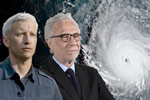May 30, 2012
By CYNTHIA MAHR
For most the thought of nuclear bombs evoke images of incinerated cities, orphaned children and scorched livestock. During the Cold War nuclear destruction was a real and constant threat. Along with tailfins and transistor radios, the 1950s and 1960s were the era of so many “duck-and-cover” public safety films. There could be, however, a brighter side to the bomb. In fact, this brighter side might soon shine on Santa Marino. The amber glow of a nuclear blast could soon shine on Santa Marino.
The amber glow of a nuclear blast could soon shine on Santa Marino.
Under a proposal dubbed “Operation Neptune” and passed yesterday by the City Council, a retired 25-kiloton Mark 7 nuclear bomb will be detonated approximately 200 miles off the Santa Marino coast on July 4, 2014. The primary purpose: to save endangered coral reef from tons of human sewage drifting in its direction.
Under Operation Neptune – which is still under review by the U.S. Nuclear Regulatory Commission – engineers from Cal. State Northridge nuclear will explode the Mark 7 warhead submerged approximately 1,500 feet below the ocean surface. As well as generate a magnificent plume of fire and water 3,000 feet into the atmosphere, the force of the explosion may push millions of tons of human sewage back towards the Santa Marino shoreline – and away from the reef.
“This is our best chance of saving tens of square miles of precious reef as well as show the world that Santa Marino is on the cutting edge of alternative energy.”
Many on the City Council see the opportunity to protect the environment – and make history. “This is our best chance of saving tens of square miles of precious reef as well as show the world that Santa Marino is on the cutting edge of alternative energy,” said Councilwoman Terry Shriver-Green. “This reef serves as the home for many endangered organisms, and [Operation] Neptune will provide a ‘wow’ factor for residents and visitors alike that is unmatched.”
 An example of a Mark VII device being prepared to be mounted to fixed wing aircraft.Councilman Bert Weinstein voted against the Operation Neptune along with two other council members. “I applaud the Board’s imagination, but am not comfortable with the science presented to the Council or the use of atomic bombs. If the reef could talk to us, I think it would say ‘no more nukes.’”
An example of a Mark VII device being prepared to be mounted to fixed wing aircraft.Councilman Bert Weinstein voted against the Operation Neptune along with two other council members. “I applaud the Board’s imagination, but am not comfortable with the science presented to the Council or the use of atomic bombs. If the reef could talk to us, I think it would say ‘no more nukes.’”
Area environmentalists are divided on the proposed novel use of nuclear power. Those defending marine life generally support Operation Neptune. “Let’s face it, the reef cannot pick up and move,” said marine preservationist Victor Shaw. “It took 10,000 years for this reef to grow, but we can save it in an instant.”
Others remain unconvinced and wary of an atomic explosion so close to Santa Marino’s downtown. Professor of nuclear science Raj Tehranjani believes organizers have failed to consider a number of risks. “This might sound like I’m making a joke, but they may very well give life to the colloquial term ‘shitstorm.’ All of the sewage within 10 miles of ground zero will lift into the atmosphere and come back down during the first heavy rain.” Dr. Tehranjani also doubts the plan will necessarily save the reef. “The offending water will fly in all directions, including over the reef.”
“This might sound like I’m making a joke, but they may very well give life to the colloquial term ‘shitstorm.’”
Nuclear engineer Donald Most, Ph.D. of U.C. Davis fears that Mark 7’s yield might surpass predictions and damage downtown Santa Marino. “The scientists that built and tested these bombs are retired or are gone. We don’t really know how this instrument will detonate and how intense the shock wave will be on the coast line,” said Dr. Most.
Although most experts agree that the risk of fallout is minimal due to the underwater detonation, authorities will recommend that children and pregnant women remain indoors for 12 hours following the blast.
The Mark 7 was in service from 1952 to 1968 with 1700-1800 having been built. It was a “dial-a-yield” capsule-type weapon with fissionable elements stored in a separate container. It formed the basis of many weapons, most notably the Mark 90 Betty nuclear depth charge.




